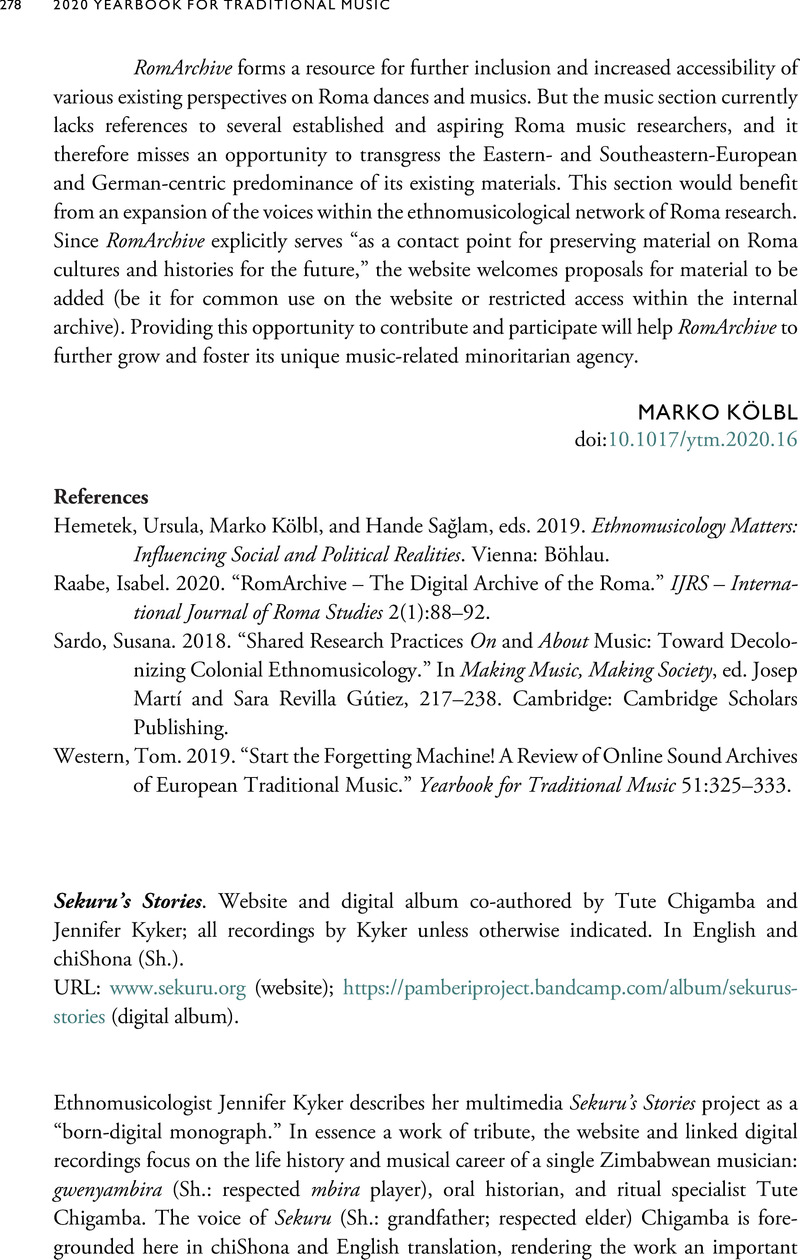No CrossRef data available.
Article contents
Sekuru’s Stories. Website and digital album co-authored by Tute Chigamba and Jennifer Kyker; all recordings by Kyker unless otherwise indicated. In English and chiShona (Sh.). URL: www.sekuru.org (website); https://pamberiproject.bandcamp.com/album/sekurus-stories (digital album).
Published online by Cambridge University Press: 18 December 2020
Abstract
An abstract is not available for this content so a preview has been provided. Please use the Get access link above for information on how to access this content.

- Type
- Multimedia Reviews
- Information
- Copyright
- © International Council for Traditional Music 2020
References
Berliner, Paul. [1978]1993. The Soul of Mbira: Music and Traditions of the Shona People of Zimbabwe. Chicago: University of Chicago Press.Google Scholar
Berliner, Paul. 2020. The Art of Mbira: Musical Inheritance and Legacy. Chicago and London: University of Chicago Press.Google Scholar
Brenner, Klaus-Peter. 1997. Chipendani und Mbira. Musikinstrumente, nicht-begriffliche Mathematik und die Evolution der harmonischen Progressionen in der Musik der Shona in Zimbabwe [Chipendani and Mbira. Musical Instruments, Implicit Mathematics and the Evolution of Harmonic Progressions in the Music of the Shona of Zimbabwe]. Göttingen: Verlagsbuchhandlung Vandenhoeck & Ruprecht.Google Scholar
Grupe, Gerd. 2004. Die Kunst des Mbira-Spiels. The Art of Mbira Playing. Harmonische Struktur und Patternbildung in der Lamellophonmusik der Shona in Zimbabwe [Harmonic Structure and Patterning in the Lamellophone Music of the Shona in Zimbabwe]. Tutzing: Hans Schneider.Google Scholar
Jones, Claire. 2019. “Shona Mbira Tunings and the Production of New Sounds: Modal Tunings and the Emergence of the Mbira Orchestras.” In Mbira Music | Musics: Structures and Processes, ed. Brenner, Klaus-Peter, 201–234. Hildesheim: Olms.Google Scholar
Matiure, Perminus. 2009. “The Relationship between Mbira Dzavadzimu Modes and Zezuru Ancestral Spirit Possession.” MA thesis, University of KwaZulu-Natal, Durban, South Africa.Google Scholar
Moon, Jocelyn Aimee. 2018. “Karimba: The Shifting Boundaries of a Sacred Tradition.” African Music 10(4):103–125.CrossRefGoogle Scholar
Tracey, Andrew. 1970. “The Matepe Mbira Music of Rhodesia.” African Music 4(4):37–61.CrossRefGoogle Scholar
Tracey, Andrew. 1972. “The Original African Mbira?” African Music 5(2):85–104.CrossRefGoogle Scholar
Tracey, Andrew. 1989. “The System of the Mbira.” In Papers Presented at the Seventh Symposium on Ethnomusicology, University of Venda, South Africa, 3–5 September 1988, 43–55. Grahamstown, South Africa: International Library of African Music.Google Scholar
Turino, Thomas. 2000. Nationalists, Cosmopolitans, and Popular Music in Zimbabwe. Chicago: University of Chicago Press.CrossRefGoogle Scholar
Yeku, James. 2019. “Review: Sekuru’s Stories.” Reviews in Digital Humanities. https://reviewsindh.pubpub.org/pub/sekurus-stories/release/14?fbclid=IwAR3GZvYkjsRO1Fk9YFZixbO5PCMU7Futyuuhxqt-5XaoszvDoFKGtC-gIis (accessed 16 June 2020).Google Scholar




